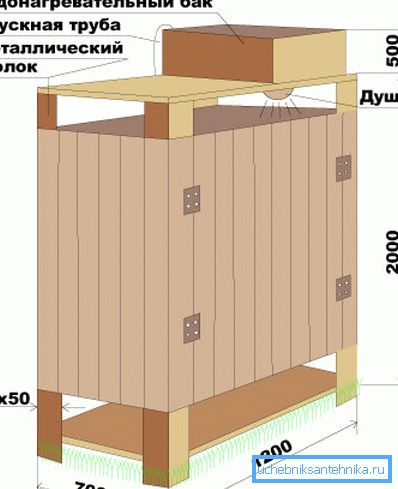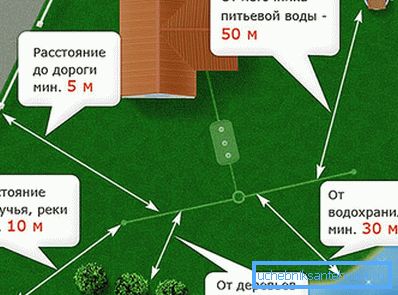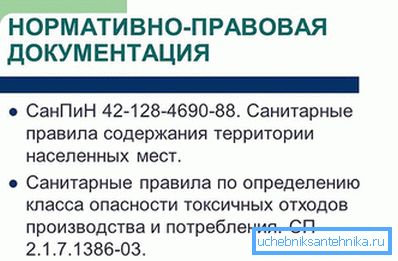Sanitary standards for cesspit
The construction of an individual dwelling house in settlements, including rural, is carried out in accordance with the current town-planning legislation, construction norms and rules, as well as sanitary and environmental legislation. The simplest and less expensive method of local sewage is the construction of a conventional cesspool. The process of construction of the cesspool must fully meet the established requirements, otherwise the house will not be put into operation, and for violations of the norms for waste disposal will be brought to justice with fines. But these are not the main reasons. Sanitary standards for the cesspool are aimed at ensuring the health of the people living in the district and the observance of environmental safety in the territory. It is very easy to poison with harmful substances from the sewage system that have fallen into the source of drinking water supply.
The autonomous sewer system can be divided into three components:
- in-house sewer network;
- external sewer network;
- device for the collection, recycling and disposal of waste.
For each element established regulatory requirements.
Regulations

Intra-house sewer network is designed taking into account the requirements established by the Code of Rules SP 30.13330.2012 “Internal water supply and sewerage of buildings. Updated version of SNiP 2.04.01-85 * ”.
The external sewerage network and cesspool are designed according to the code of rules SP 32.13330.2012 “Sewerage. External networks and facilities. Updated version of SNiP 2.04.03-85 "and SP 31.13330.2012" Water supply. External networks and facilities. Updated version of SNiP 2.04.02-84 ". That is, the abovementioned SNiPs are not effective from January 1, 2013.
A new set of rules device cesspool without bottom is prohibited. Also, new building codes do not contain the concept of "cesspool". For the organization of the local cleaning system of a detached house the concept of "septic tank" is used. The septic tank (pit) must be completely sealed and exclude the slightest possibility of sewage getting into the ground to prevent environmental pollution. The accumulator of waste must ensure the safety of its operation. As the septic tank is filled with waste, it must be pumped out by an after-collecting machine. At least twice a year, the septic tank should be completely cleaned and inspected for damage. Depth should take into account the groundwater level, but not exceed 3 meters. In the case of high groundwater they should not fall inside the septic tank.
Device requirements

The bottom of the septic tank should have a slope to the side under the hatch. Tightness of the cesspool should be ensured by sealing the inner and outer surfaces of the hermetically sealed cover.
It is more expedient to build a septic tank from concrete rings on a concrete base. From above, it should be closed with a lid with an inspection hatch, which also serves as a hatch for pumping drains. All joints must be embedded and completely sealed.
When the drive device is the incoming sewer pipe is mounted closer to the lid. When installing above the level of soil freezing, sewer pipes and a septic tank are warmed. To eliminate the appearance of unpleasant odors suit vents. Ventilation stand is displayed above the ground at 70–80 cm.
Location

SNiP 2.07.01-89 “Urban planning. Planning and development of urban and rural settlements ”set the minimum distance from the foundation of a residential house to the sewage facilities, which must be at least 3 meters.
The minimum distance from the pit to the sources of water supply should be from 30 to 50 meters, depending on the type of soil.
SanPiN

When constructing cesspools, it is necessary to adhere to sanitary standards, which are established in paragraph 2.3 of SanPiN 42-128-4690-88. "Sanitary rules for maintaining the territories of populated areas".
- In the absence of centralized sewage systems, yard dumps with a waterproof grab and a ground cover are arranged.
- Sanitary regulations also prohibit the use of pits without a bottom.
- The vault should completely eliminate the possibility of sewage entering the environment without cleaning.
- When constructing a cesspool, the above-ground part should have a hermetically sealed hatch, as well as a grate below the inlet sewer pipe and a compartment for collecting solid waste trapped in the sewer system (food waste, thick paper, cotton wool, etc.).
- The distance from an apartment building to the drive is determined by the landlord himself, but should not be less than 8–10 meters.
- The distance to the drain hole from the house for sanitary standards exceeds the minimum distance for building codes.
- Sewer facilities should be located from water sources at a distance of at least 50 meters.
- The drive should be located in a convenient place for the aspeni-maker to enter a place for which there should be no interference.
- The cesspool should be disinfected with various solutions: bleach (10%), sodium hydrochloride (3-5%), lysol (10%), creolin (5%). The use of dry bleach is strictly prohibited.
Sanitary standards have more stringent requirements for the placement and maintenance of waste storage than building standards.
For the correct location of all objects on the site you need to draw a diagram of the site and the planned location of the house, water source, engineering networks. It should take into account the location of similar objects in neighboring areas. The design of the house and the placement of the sump should be coordinated with the regulatory authorities.
Video
This video describes sanitary standards for well and septic tanks: